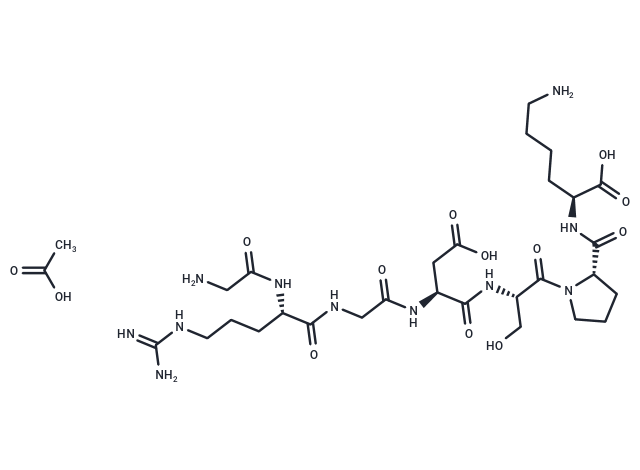Shopping Cart
Remove All Your shopping cart is currently empty
Your shopping cart is currently empty
GRGDSPK acetate shows inhibitory activity against integrin-fibronectin binding and can be used in research on integrins in bone formation and resorption.

| Pack Size | Price | USA Warehouse | Global Warehouse | Quantity |
|---|---|---|---|---|
| 1 mg | $82 | - | In Stock | |
| 5 mg | $188 | - | In Stock | |
| 10 mg | $277 | - | In Stock | |
| 25 mg | $413 | - | In Stock | |
| 50 mg | $580 | - | In Stock | |
| 100 mg | $791 | - | In Stock | |
| 200 mg | $1,060 | - | In Stock |
| Description | GRGDSPK acetate shows inhibitory activity against integrin-fibronectin binding and can be used in research on integrins in bone formation and resorption. |
| In vitro | By measuring calcium content and 70 bonehnit area of tissue in parietal bones 18 days old isolated from pregnant Sprague-Dawley rats, we know that GRGDSPK (EMD 56574; RGD; 0.1-50 μM; for 4 days) inhibits mineralization in a dose-dependent manner.[1] Treatment with GRGDSPK (10 and 50 μM; 4-day treatment) results in significant alterations in bone morphology, characterized by disruptions in the organization of osteoblasts and the mineralized matrix.[1] In the presence of GRGDSPK peptide (RGD; 250 μM), added to the medium, the binding between integrins and fibronectin is effectively blocked, leading to a considerable increase in the average size of cell aggregates in wild-type cells.[2] Addition of GRGDSPK (250 μM) leads to a significant reduction in adhesion forces and work exerted by wild-type mesendodermal progenitors, indicating the involvement of integrins expressed in these progenitors and the specificity of the detachment parameters recorded for fibronectin.[2] GRGDSPK (RGD-containing, 1.5 mM, 1.0 mM, and 0.5 mM) and RGD-modified peptides, at concentrations of 1.5 mM, 1.0 mM, and 0.5 mM, impair the fertilization ability of bovine oocytes by sperm cells, resulting in a dose-dependent reduction in cleavage rates.[3] |
| Synonyms | GRGDSPK acetate(111119-28-9 Free base) |
| Molecular Weight | 775.81 |
| Formula | C30H53N11O13 |
| Cas No. | 144027-77-0 |
| Smiles | C(C)(O)=O.C([C@@H](NC([C@@H](NC(CNC([C@H](CCCNC(=N)N)NC(CN)=O)=O)=O)CC(O)=O)=O)CO)(=O)N1[C@H](C(N[C@@H](CCCCN)C(O)=O)=O)CCC1 |
| Relative Density. | no data available |
| Color | White |
| Appearance | Solid |
| Sequence | H-Gly-Arg-Gly-Asp-Ser-Pro-Lys-OH Acetate |
| Sequence Short | GRGDSPK |
| Storage | store at low temperature,keep away from moisture | Powder: -20°C for 3 years | In solvent: -80°C for 1 year | Shipping with blue ice/Shipping at ambient temperature. | ||||||||||||||||||||
| Solubility Information | DMSO: 7.76 mg/mL (10 mM), Sonication is recommended. | ||||||||||||||||||||
Solution Preparation Table | |||||||||||||||||||||
DMSO
| |||||||||||||||||||||
| Size | Quantity | Unit Price | Amount | Operation |
|---|

Copyright © 2015-2026 TargetMol Chemicals Inc. All Rights Reserved.